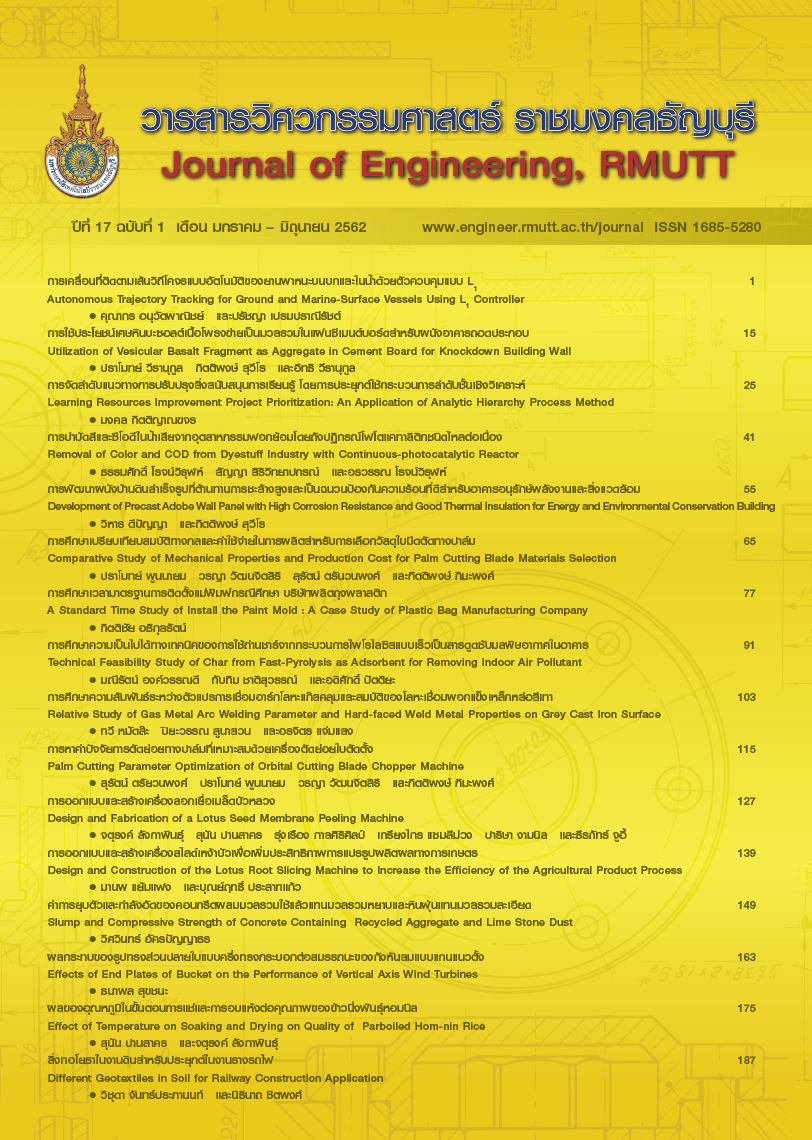Design and Fabrication of a Lotus Seed Membrane Peeling Machine
Main Article Content
Abstract
The research was to design and fabricate a lotus seeds membrane peeling machine to minimize the time and labor requirement in the processing of OTOP products of the provinces with lotus planting areas. The prototype consists of the main frame, lotus seed membrane peeling unit, the power transmission unit, and a 0.5 hp electric motor, which was used as a prime mover. In the operation, the 0.5 kg lotus seeds and 1.5 lites of water were fed manually into feeding chute at the top of the machine to peel the lotus seed membrane in the peeling unit. After the peeling, lotus seeds were released through outlet chute at the bottom. Results of testing at the peeling speed of 1,000, 1,200 and 1,400 rpm, and testing time at 3, 4, 5, 6 and 7 min, respectively indicated that the optimal performance was achieved when the machine was operated 4 min at peeling speed 1,200 rpm. The working capacity was 7.1 kg/hour, percentage of peeling was found to be 94.5% with seed damaged 2.9%, and consumed 0.66 kW-hour of energy. An engineering economic analysis showed that, at an annual usage rate of 1,440 hours, the machine cost was on average of 3.9 THB per kilogram, payback period of 3.4 years and the break-even point of the machine was 1,170 hours per year.
Article Details
The manuscript, information, content, picture and so forth which were published on Frontiers in engineering innovation research has been a copyright of this journal only. There is not allow anyone or any organize to duplicate all content or some document for unethical publication.
References
Suksawat W.7 benefits of Thai grains [Internet]. Bangkok. 2017 Jun-[cited 2018 April 23];
Available from: http://www.tnews.co.th/contents.
Lotus production situation [Internet]. Bangkok. Department of Agriculture Extension. [updated 2017 May 16; cited 2018 Jul 9]. Available from: http://www.doae.go.th/LIBRARY/.
Suwannaro T. Lotus farming. Extension and Training Office. Bangkok: Kasetsart University; 2007.
Lotus field in Nakhon Phanom province of Thailand [Internet]. Bangkok, Matichon Online. 2016 Jun- [cited 2016 Feb 16]. Available from: http://www.matichon.co.th/news.
Mueangsuk S. Lotus farming in Bueng Kan [Internet]. Bangkok, khaosod Online. 2016 Feb- [cited 2016 Feb 15]. Available from: https://www.khaosod.co.th/view_newsonline.php?newsid.
Vijitwittayapong P. 2552. Lotus seeds product of Phichit [Internet]. Bangkok, Matichon Online. 2013 Jun- [cited 2013 Feb 13]. Available from: http://www.matichon.co.th/matichon/view_news.
Pimparain P, Srisudto P, and Upmagay T. Design and development of a lotus seed peeling machine. [Engineering Project]. Pathum thani: Rajamangala University of Technology Thanyaburi; 2009. (in Thai)
Langkapin J, Parnsakhorn S, Kalsirisilp R, Prorod M, and Khotpromsrt N. Study and testing of a lotus seed peeling machine. Journal of Engineering RMUTT. 2018;1:35-42. (in Thai)
Langkapin J. Theory of agricultural machines. 1st ed. Bangkok: Triple Education Co., Ltd; 2015. (in Thai)
Krutz, G, Thomson, L and Claar, P. Design of agricultural machinery. 1st ed. New York: John Wiley and Sons, 1994.
Shigley, J.E. and Mischke, C.R. Mechanical engineering design. 5th ed, USA: McGraw-Hill Book Company; 1989.
Langkapin J. Solidworks. 3nd. Bangkok: Triple Education Co., Ltd; 2018. (in Thai)
Hunt, D. Farm power and machinery. 10th ed. Iowa, USA: Iowa State University Press; 2001.

